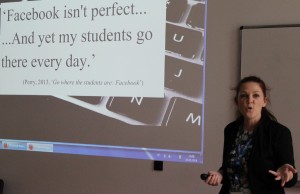Facebook? I know, I told you I didn’t have an account. Well, that wasn’t exactly true…
I was fortunate to attend, and also to present at, the English for Academic Purposes (EAP) Conference on May 10, in Potsdam, not far from Berlin. The event was hosted by the University of Potsdam, in partnership with the English Language Teachers’ Association Berlin-Brandenburg (ELTABB). My talk was called Expanding the ESL classroom with Facebook Groups.
There was a range of interesting workshops and presentations taking place all connected to English for Academic Purposes. The conference was very well organised and I particularly liked the fact that there was plenty of opportunity to meet and chat to other participants. The day was not spent rushing from room to room as can be the case at such events. Instead, there were coffee breaks, a long lunch and a post conference Korean-American Barbecue, all of which encouraged conversation and helped spread the relaxed, friendly and supportive vibe.
I took part in a workshop by Julie Moore (@lexicojules) on How to create effective EAP materials, and later a presentation by Laura Adele Soracco (@LauraSoracco) on Exploring Ways of Using Flashcards to Learn Vocabulary. Both were enjoyable as well as being incredibly useful, and I really felt I was coming away with practical ideas I could immediately put into practice. I have experience creating test materials, yet Julie’s presentation gave me a different perspective, as writing for teaching is different from writing for testing, and one word I’m keeping in mind is ‘Scaffolding’. (For more information, I recommend her ebook How to Write EAP Materials.)
Laura made me realise how much more I could be doing to help my students master new vocabulary. I must admit, I had not been using flashcards with my university groups, something I am definitely going to change. (Quizlet seemed to be a popular tool. When Laura mentioned it, many heads nodded in recognition.)
She also introduced me to just-the-word.com, which I think my students will find really helpful, particularly the ‘show combinations’ feature.
Both speakers mentioned the Nottingham Academic Word List highlighter (AWL Highlighter) which I am using daily- at the moment more for my own amusement than anything else – but it is really a great tool for identifying key academic vocabulary in any text, and one I will be taking advantage of next semester.
With all these great tips and tools, it’s no wonder I came away so inspired!
Link to Julie Moore’s blog post on EAP 2014: http://lexicoblog.blogspot.de/2014/05/eap2014-potsdam-berlin.html
Link to Laura Adele Soracco’s blog http://tesolthoughts.wordpress.com

Despite being slightly nervous beforehand, my talk ‘Expanding the ESL classroom with Facebook Groups’ went very well. I really enjoyed it, particularly the Q&A session afterwards.
I’m posting a shortened version here, with some additional notes posted on the slides. It is based on my experience teaching English to Media and Marketing students at a private university here. The students are grouped by subject and their levels range from B1 to C2 – yes… C2! I’ve complemented students on their accents or vocabulary, only to hear ‘Oh, my mum’s from Manchester’, or ‘Well, I lived in Chicago for 11 years.’ I tried Facebook groups as a means of keeping everyone motivated, encouraging students to use English outside of class, allowing for differentiation, and getting them sharing and collaborating. I’m still learning, but so far it has been incredibly helpful and something that has become an important part of all my EAP classes.
Try it out!












